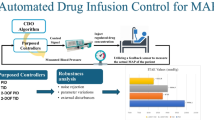Abstract
Infusion Stand is one of the medical supportive tools in the field of biomedical that assist in holding and carrying medications to patients via intravenous injections. Mobilization of Infusion Stand from a place to another place is necessary not only for the patients itself but also for the nurses. Therefore, this leads to not only uneasiness but also inconvenience for both parties. Therefore, to improve the existing situation and current Infusion Stand in the market, a proposal to design and implement a prototypic Robotic Infusion Stand is submitted. In this paper, 2-Degree of Freedom Proportional Integral Derivative (2-DOF PID) controller is proposed for Robotic Infusion Stand after comparison between 1-Degree of Freedom Proportional Integral Derivative (1-DOF PID) to find the most suitable controller. Analysis of reference tracking, disturbance rejection and controller effort are performed which demonstrate the ability of the proposed approach within the system parameters.
Access this chapter
Tax calculation will be finalised at checkout
Purchases are for personal use only
Similar content being viewed by others
References
Graham, D.R., Keldermans, M.M., Klemm, L.W., Semenza, N.J., Shafer, M.L.: Infectious complications among patients receiving home intravenous therapy with peripheral, central, or peripherally placed central venous catheters. Am. J. Med. 91(3), S95–S100 (1991)
Sayed-Kassem, A., Ghandour, A., Hamawy, L., Zaylaa, A.J.: Cutting-edge robotic intravenous pole: preliminary design and survey in academic medical center in Lebanon. J. Biomed. Eng. Med. Dev. 2(1), 1–9 (2017)
Simons, S.H., Van Dijk, M., van Lingen, R.A., Roofthooft, D., Duivenvoorden, H.J., Jongeneel, N., Tibboel, D.: Routine morphine infusion in preterm newborns who received ventilatory support: a randomized controlled trial. JAMA 290(18), 2419–2427 (2003)
Vignali, M.: Intravenous Stand Design. Project Partners from Huazhong University of Science and Technology, China (2006)
Wilt Jr., C.F.: St. Joseph’s Hospital, Medical Center, assignee. Apparatus for facilitating intravenous feeding during transportation of patient. United States Patent US 4,511,157 (1985)
Qureshi, M.O., Syed, R.S.: The impact of robotics on employment and motivation of employees in the service sector, with special reference to health care. Saf. Health Work 5, 198–202 (2014)
Binger, M., Conway, C., Goddard, N., Jacobs, N., Pysher, C., et al.: Project Number: P15073 Autonomous IV Stand
Westbrook, J.I., Rob, M.I., Woods, A., Parry, D.: Errors in the administration of intravenous medications in hospital and the role of correct procedures and nurse experience. BMJ Quality Saf. 20(12), 1027–1034 (2011)
Carelli, L., Gaggioli, A., Pioggia, G., De Rossi, F., Riva, G.: Affective robot for elderly assistance. Stud. Health Technol. Inform. 144(2009), 44–49 (2009)
Qureshi, M.O., Syed, R.S.: The impact of robotics on employment and motivation of employees in the service sector, with special reference to health care. Saf. Health Work 5(4), 198–202 (2014)
Azar, A.T., Eljamel, M.S.: Medical robotics. In: Sobh, T., Xiong, X. (eds.) Prototyping of Robotic Systems: Applications of Design and Implementation. IGI Global, USA (2012). ISBN 978-1466601765
Åström, K.J., Hägglund, T.: PID Controllers: Theory, Design and Tuning. Instrument Society of America, Research Triangle Park (1995)
Azar, A.T., Vaidyanathan, S.: Computational Intelligence Applications in Modeling and Control: Studies in Computational Intelligence, vol. 575. Springer, Germany (2015). ISBN 978-3-319-11016-5
Azar, A.T., Vaidyanathan, S.: Handbook of research on advanced intelligent control engineering and automation. In: Advances in Computational Intelligence and Robotics (ACIR) Book Series. IGI Global, USA (2015). ISBN 9781466672482
Sung, S.W., Lee, I.B.: Process Identification and PID Control. Wiley, Singapore (2009)
Azar, A.T., Serrano, F.E.: Robust IMC-PID tuning for cascade control systems with gain and phase margin specifications. Neural Comput. Appl. 25(5), 983–995 (2014). https://doi.org/10.1007/s00521-014-1560-x
Blum, J.: Exploring Arduino: Tools and Techniques for Engineering Wizardry. Wiley, London (2013)
Immega, G., Antonelli, K.: The KSI tentacle manipulator. In: 1995 IEEE International Conference on Robotics and Automation, vol. 3, pp. 3149–3154. IEEE (1995)
Ritchie, G.J., Turner, J.A.: Input devices for interactive graphics. Int. J. Man Mach. Stud. 7(5), 639–660 (1975)
Rech, C., Pinheiro, H., Grundling, H.A., Hey, H.L., Pinheiro, J.R.: Analysis and design of a repetitive predictive-PID controller for PWM inverters. In: 2001 IEEE 32nd Annual Power Electronics Specialists Conference, PESC, vol. 2, pp. 986–991, IEEE (2001)
Adar, N.G., Kozan, R.: Comparison between real time PID and 2-DOF PID controller for 6-DOF robot arm. Acta Phys. Pol. A 130(1), 269–271 (2016)
Author information
Authors and Affiliations
Corresponding author
Editor information
Editors and Affiliations
Rights and permissions
Copyright information
© 2019 Springer Nature Switzerland AG
About this paper
Cite this paper
Azar, A.T., Hassan, H., Razali, M.S.A.B., de Brito Silva, G., Ali, H.R. (2019). Two-Degree of Freedom Proportional Integral Derivative (2-DOF PID) Controller for Robotic Infusion Stand. In: Hassanien, A., Tolba, M., Shaalan, K., Azar, A. (eds) Proceedings of the International Conference on Advanced Intelligent Systems and Informatics 2018. AISI 2018. Advances in Intelligent Systems and Computing, vol 845. Springer, Cham. https://doi.org/10.1007/978-3-319-99010-1_2
Download citation
DOI: https://doi.org/10.1007/978-3-319-99010-1_2
Published:
Publisher Name: Springer, Cham
Print ISBN: 978-3-319-99009-5
Online ISBN: 978-3-319-99010-1
eBook Packages: Intelligent Technologies and RoboticsIntelligent Technologies and Robotics (R0)




